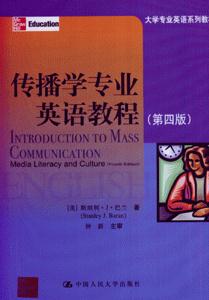-
>
鲍勃·迪伦诗歌集:1961-2012:典藏版
-
>
双城记-英文版
-
>
四级词汇词根+联想记忆法:乱序版
-
>
The secret garden
-
>
哈克贝利.费恩历险记/床头灯英语.2000词读物(英汉对照)
-
>
10000德语分类词汇联想记忆
-
>
英语词汇全书
传播学专业英语教程-(第四版) 版权信息
- ISBN:9787300089089
- 条形码:9787300089089 ; 978-7-300-08908-9
- 装帧:暂无
- 册数:暂无
- 重量:暂无
- 所属分类:>>
传播学专业英语教程-(第四版) 本书特色
《传播学专业英语教程》(第四版)是一本经典的传播学教
材。该书介绍了大众传播学的基本概念及媒介产业的相关知识,
系统地介绍了传统的图书、报刊、影视、广播以及新兴的互联
网等信息传播媒介的起源、现状及未来趋势。本教材案例新颖、
内容生动有趣、教学支持体系完善,经改编、注释后适合专业
英语教学及双语教学的需要,尤其便于多媒体教学。
大学专业英语系列教材还包括:
法学专业英语教程(第二版上、下)
管理学专业英语教程(第二版上、下)
经济学专业英语教程(第二版上、下)
人文科学专业英语教程(第二版上、下)
西方经济学经典名著选读(第二版)
西方历史学经典名著选读(第二版)
西方法学经典名著选读
传播学专业英语教程-(第四版) 节选
eace
N SEPTEMBER 11, 2001, MILLIONS OF AMERICANS--IN FACT, millions
of people around the globe--went to bed in shock. The world had
changed. The United States no longer seemed invincible. Americans no
longer felt safe at home. As everyone, from politicians to pundits to the
people next door, said, "Nothing would ever be the same again." Much, in
fact, is the same; but not our view of the mass media. The questions we were
asking about media in the immediate aftermath of 9/11 and the questions
we are raising now are shaped in large part by what happened on that
horrific day.
At first we were impressed, even moved, by the performance of our
mass media. The coverage of the attack and rescue effort in all media was
thorough, knowledgeable, courageous, even-handed, and sensitive. But then
we started asking, Why were we caught so badly by surprise? Why didn't
we know about the anti-American feelings in much of the world? Where
were the media? This question was asked again and again as the invasion
of Iraq produced none of the weapons of mass destruction that had been
the cause belli. Had the media been too compliant? Was their lack of aggres-
sive checking a function of economic factors such as concentration and
conglomeration? Were the media's failures in the run-up to war the fuel
igniting an invigorated media reform movement at home on the political
Right as well as the Left?
But it did not take a cowardly terrorist attack on civilians or an inva-
sion of a hostile country to start people thinking and talking about the
media. September 11 and the war in Iraq chased from the cultural forum
the relentless criticism of the media performance in the 2000presidential
elections.Dan Rather said that Media proresslonals
their faces after that shameful failure of our democracy; they wore the
entire omelet. People questioned the media's priorities--a missing Capitol
Hill intern garnered more coverage than world events. Others were com-
plaining that movies were starting to look like extra-long commercials,
while television commercials were getting increasingly shorter and all
media, even novels, were seemingly drowning in more and more advertis-
ing. Critics across the political spectrum were concerned that media com-
panies were merging at an unhealthy-for-democracy rate. Concern about
media violence and sexual content remained unabated. Furor followed a
television network's proposal to air hard-liquor ads. People who had lost
their life savings wanted to know what the media were doing while Enron
and WorldCom were stealing from them. To First Amendment advocates,
new copyright rules designed to thwart digital piracy were undoing two
centuries of fair use copyright protection, with consumers and democracy
poorer for it.
The media, like sports and politics, are what we talk about. Argue over.
Dissect and analyze.
Those of us who teach media know that these conversations are essen-
tial to the functioning of a democratic society. We also know that what
moves these conversations from the realm of chatting and griping to that of
effective public discourse is media education--the systematic study of
media and their operation in our political and economic system, as well as
their contribution to the development and maintenance of the culture that
binds us together and defines us. W
传播学专业英语教程-(第四版) 作者简介
p>About the Author
BARAN EARNED HIS IN COMMUNICA-
PH.D.
TION research at the University of Massachusetts
after taking his M.A. in journalism at Pennsylvania State
University. He taught for 4 years at Cleveland State Uni-
versity, eventually moving to the University of Texas. He
led the Department of Radio-TV-Film's graduate pro-
gram for 6 of his 9 years in Austin and won numerous
teaching awards there, including the AMOCO Teaching
Excellence Award as the best instructor on that 40,000
student campus, the College of Communication's Teach-
ing Excellence Award as that college's outstanding pro-
fessor, and Utmost Magazine's Student Poll for best
instructor. Dr. Baran moved to San Jose State Univer-
sity in 1987 and served 9 years as chair of the Department of Television,
Radio, Film, and Theatre. At SJSU he was named President's Scholar as the
university's outstanding researcher. Now, he teaches at Bryant University,
where he is the founding chairman of that school's Communication Depart-
ment. Among the other experiences that helped shape this book are his serv-
ice as a judge for the Fulbright Scholar Awards and his many years of pro-
fessional activity in audience research, writing for radio, and producing for
television. Dr. Baran has published 10 books and scores of scholarly arti-
cles, and he sits or has sat on the editorial boards of five journals. His work
has been translated into half a dozen languages. He is a skilled sailor and
plays tenor sax in the Wakefield, Rhode Island, Civic Band. He is
- >
名家带你读鲁迅:故事新编
名家带你读鲁迅:故事新编
¥13.0¥26.0 - >
莉莉和章鱼
莉莉和章鱼
¥18.1¥42.0 - >
诗经-先民的歌唱
诗经-先民的歌唱
¥15.1¥39.8 - >
史学评论
史学评论
¥13.9¥42.0 - >
我从未如此眷恋人间
我从未如此眷恋人间
¥16.4¥49.8 - >
有舍有得是人生
有舍有得是人生
¥31.5¥45.0 - >
月亮与六便士
月亮与六便士
¥13.4¥42.0 - >
名家带你读鲁迅:朝花夕拾
名家带你读鲁迅:朝花夕拾
¥10.5¥21.0
-
汉译英基础教程:外语院校翻译系列教材
¥8.6¥27 -
财政学专业英语
¥9.5¥28 -
2022图书×抽奖盲袋
¥9.9¥25 -
2023读书月阅读盲盒——天黑,闭眼,刀谁?
¥42.3¥158 -
2022读者节纪念徽章-三星会员专属
¥45¥45.6
















